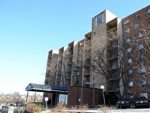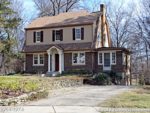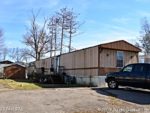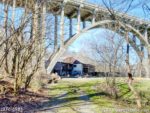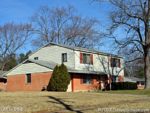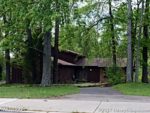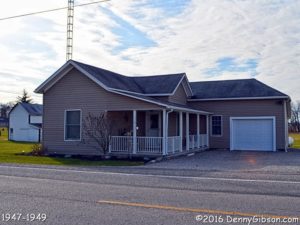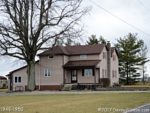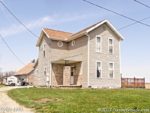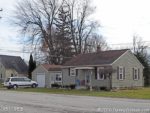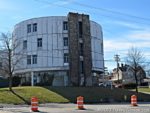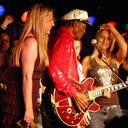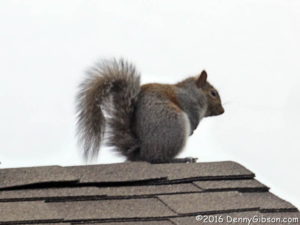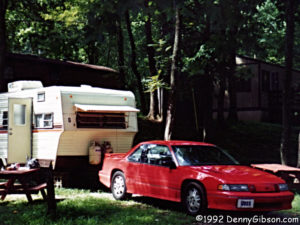 The Storm was fun to drive but was completely inadequate in terms of people hauling. As the 1992 model year came to an end, a bright red Chevrolet Lumina Z34 sitting unsold at the dealer where I’d bought the Geo caught my eye. Enough time had passed since the divorce to let my credit recover to the point I could buy it even though I still owed on the Storm and wasn’t trading it in. It became a graduation gift to my oldest son and he drove it to his new home in San Francisco.
The Storm was fun to drive but was completely inadequate in terms of people hauling. As the 1992 model year came to an end, a bright red Chevrolet Lumina Z34 sitting unsold at the dealer where I’d bought the Geo caught my eye. Enough time had passed since the divorce to let my credit recover to the point I could buy it even though I still owed on the Storm and wasn’t trading it in. It became a graduation gift to my oldest son and he drove it to his new home in San Francisco.
I suspect there were several reasons why the Z34 was hanging around. One may have been price. The typical Lumina was a mid-sized reasonably-priced family-friendly car. The Z34 model not so much. As the performance model it carried a premium and having just two doors somewhat reduced its utility. The bright color and the manual transmission may have also eliminated a few perspective owners. While those things may have made it less desirable to some, they were — except for the price — the very things that attracted me. In the end, the need to “make room for the ’93s” made even the price kind of attractive.
The Chevy was an almost ideal vehicle for me at that time. It held four adults in tolerable comfort which made chauffeuring my daughter and a friend or two absolutely painless. I could even do the lunchtime driving for small groups of coworkers and that was something that had simply not been possible with the Storm. Plus it was fun.
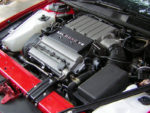 I’ve always liked shifting my own gears. That’s something I’d been reminded of with the Mazda as well as the Storm so the 5-speed manual was a big plus for me. The front wheel drive Storm didn’t handle quite as well as the rear drive Mazda but it was pretty good. The FWD Lumina was bigger than either of those so did not handle as well as either but it was a long way from bad. Plus it could go — and stop — quite well indeed. The 34 in the model designation came from its 3.4 liter V6 engine. With two overhead camshafts on each cylinder bank, this was a pretty exotic engine for General Motors. To this day, it remains the only car I’ve owned with just as many cams as wheels. Output was 210 HP. Four-wheel ABS discs did the stopping. I’ve since owned other cars with this brake setup but the Z34 was my first. I was impressed.
I’ve always liked shifting my own gears. That’s something I’d been reminded of with the Mazda as well as the Storm so the 5-speed manual was a big plus for me. The front wheel drive Storm didn’t handle quite as well as the rear drive Mazda but it was pretty good. The FWD Lumina was bigger than either of those so did not handle as well as either but it was a long way from bad. Plus it could go — and stop — quite well indeed. The 34 in the model designation came from its 3.4 liter V6 engine. With two overhead camshafts on each cylinder bank, this was a pretty exotic engine for General Motors. To this day, it remains the only car I’ve owned with just as many cams as wheels. Output was 210 HP. Four-wheel ABS discs did the stopping. I’ve since owned other cars with this brake setup but the Z34 was my first. I was impressed.
The picture at the top was taken after I’d had the car just a couple of days. I did not tow the camper there. It was one of several rental units in a Kentucky campground bordering the Ohio River. I took my daughter and one of her friends camping there almost as soon as I picked up the car. The trip included a visit to the Kentucky Horse Park where the girls enjoyed some gentle horseback riding. I quit smoking.
It wasn’t exactly planned, but I had finally reached the point where I was mentally ready to quit. What tipped the scale was that smoking had just become too much of a hassle and the acquisition of a new not-yet-smoked-in car seemed a good occasion to go for it. I took no cigarettes on the trip but did take a pack of Between the Acts cigarette style cigars to use in dealing with major nicotine cravings. I essentially finished the first few I smoked but it wasn’t long before a couple of puffs would make me light-headed. I resorted to the little cigars a couple of time after we got home but I never finished the pack and I never smoked in the Lumina.
I did go racing in it though. Once. Kinda. This was the first car I went autocrossing in. Autocrossing (a.k.a. gymkhana) is a race against the clock on a course marked by orange cones. Some friends were into it and I decided to give it a try. A common arrangement is for half of the entrants to line the course as corner workers while the other half raced and then switch roles. I had never even seen an autocross but figured I’d get to watch for awhile before launch time. Nope. Not only was I in the first drivers (rather than workers) group, my slot was so early that I was in line and unable to see much of anything when the few cars in front of me made their runs. To no one’s surprise, I didn’t do well. It wasn’t horrible but it sure wasn’t competitive. I did a little better on subsequent runs but not much. The FWD Lumina was not a particularly good autocross car and I had no idea what I was doing. I would be back, however — in a different car.
My Previous Wheels: Chapter 29 — 1991 Geo Storm
My Next Wheels: Chapter 31 — 1994 Chevrolet Camaro

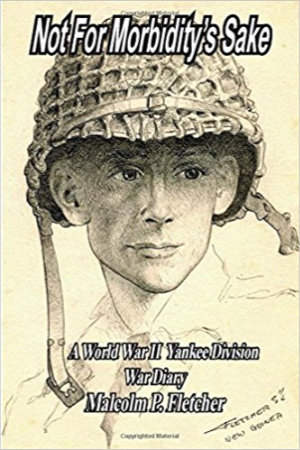 It’s a familiar story I’d never heard before. In no way is use of the word “familiar” meant to be dismissive. It’s just my way of acknowledging that many aspects of Malcolm Fletcher’s story are to be found in the stories of thousands of other World War II soldiers. Of course, each of those stories is also unique in ways both small and large. Large happenings that make Fletcher’s story unique include the actions that earned him a bronze star and the day he watched his brother get shot and captured. Getting coffee and doughnuts from the Red Cross in February and washing clothes and shaving in May are among the not-so-large pieces of the story that make it real. Numerous photographs, maps, and drawings — many by Fletcher himself — really fill things out.
It’s a familiar story I’d never heard before. In no way is use of the word “familiar” meant to be dismissive. It’s just my way of acknowledging that many aspects of Malcolm Fletcher’s story are to be found in the stories of thousands of other World War II soldiers. Of course, each of those stories is also unique in ways both small and large. Large happenings that make Fletcher’s story unique include the actions that earned him a bronze star and the day he watched his brother get shot and captured. Getting coffee and doughnuts from the Red Cross in February and washing clothes and shaving in May are among the not-so-large pieces of the story that make it real. Numerous photographs, maps, and drawings — many by Fletcher himself — really fill things out.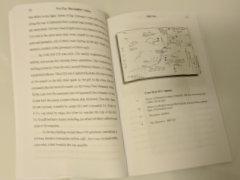 It’s a great story and well told, but there’s no denying that the mere fact that it is being shared plays a big role in setting this story apart from most of the others. The majority of those soldiers never told their story to anyone. A relative few did write it down or record it but not many saw an audience beyond family, friends, or a veterans organization. That Malcolm Fletcher wanted to share his story is obvious. He expanded his wartime notes and produced a “diary”. The title is his. Not For Morbidity’s Sake came from the fact that, as his son Michael says in the foreword, “…he took no pleasure in telling most of this story”. Malcolm Fletcher died in 1994, and Michael, with help from his brother Mark, made publication of the diary a reality. To a large degree, this meant editing their father’s writings, but they also augmented the story with information gathered from other family members, friends, and even some of the men who served with Malcolm.
It’s a great story and well told, but there’s no denying that the mere fact that it is being shared plays a big role in setting this story apart from most of the others. The majority of those soldiers never told their story to anyone. A relative few did write it down or record it but not many saw an audience beyond family, friends, or a veterans organization. That Malcolm Fletcher wanted to share his story is obvious. He expanded his wartime notes and produced a “diary”. The title is his. Not For Morbidity’s Sake came from the fact that, as his son Michael says in the foreword, “…he took no pleasure in telling most of this story”. Malcolm Fletcher died in 1994, and Michael, with help from his brother Mark, made publication of the diary a reality. To a large degree, this meant editing their father’s writings, but they also augmented the story with information gathered from other family members, friends, and even some of the men who served with Malcolm.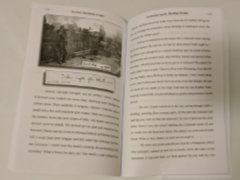 Those observations also fed some slightly philosophical thinking on the horrors of war and the brotherhood of man. He had personal experience with both. Whether the deeper of Fletcher’s thoughts came during his time in Europe or while he subsequently transcribed his notes in safety in the USA is unclear and unimportant. He was in the midst of battles where men destroyed each other with cannons, bombs, rifles, bayonets, and flame-throwers. He saw many and met a few French, Belgian, and German civilians whose world was ravaged beyond comprehension. And he was there at the end of the conflict, interacting with German and Russian soldiers to learn that “These Russies are just like us.”
Those observations also fed some slightly philosophical thinking on the horrors of war and the brotherhood of man. He had personal experience with both. Whether the deeper of Fletcher’s thoughts came during his time in Europe or while he subsequently transcribed his notes in safety in the USA is unclear and unimportant. He was in the midst of battles where men destroyed each other with cannons, bombs, rifles, bayonets, and flame-throwers. He saw many and met a few French, Belgian, and German civilians whose world was ravaged beyond comprehension. And he was there at the end of the conflict, interacting with German and Russian soldiers to learn that “These Russies are just like us.” Details of timing are lacking for both this and the following My Wheels chapter. I think I’ve got the sequence right but I’m not even entirely certain of that. The two are connected by more than a lack of precision in dates but I don’t expect this chapter to explain things very well. Hopefully I’ll be able to make things clearer in the next chapter when all the pieces have been identified.
Details of timing are lacking for both this and the following My Wheels chapter. I think I’ve got the sequence right but I’m not even entirely certain of that. The two are connected by more than a lack of precision in dates but I don’t expect this chapter to explain things very well. Hopefully I’ll be able to make things clearer in the next chapter when all the pieces have been identified.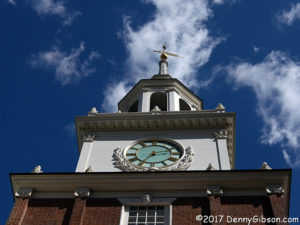
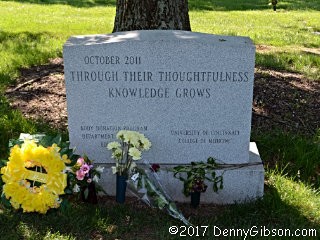 At various points in my youth I dreamed of making major contributions to the welfare of mankind. Maybe discovering a cure for cancer or inventing an anti-gravity machine or a device for traveling through time. But chemistry and I barely became acquaintances let alone friends and my relationship with higher math and hard core physics wasn’t anything to brag about either. I had some success playing with computer software and I believe that some of what I did was actually creative but it wasn’t the sort of thing that advanced the state of computer science. But there’s still a chance. I’ve just made arrangements for my body to go to the
At various points in my youth I dreamed of making major contributions to the welfare of mankind. Maybe discovering a cure for cancer or inventing an anti-gravity machine or a device for traveling through time. But chemistry and I barely became acquaintances let alone friends and my relationship with higher math and hard core physics wasn’t anything to brag about either. I had some success playing with computer software and I believe that some of what I did was actually creative but it wasn’t the sort of thing that advanced the state of computer science. But there’s still a chance. I’ve just made arrangements for my body to go to the 
